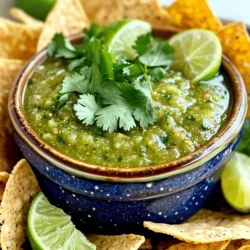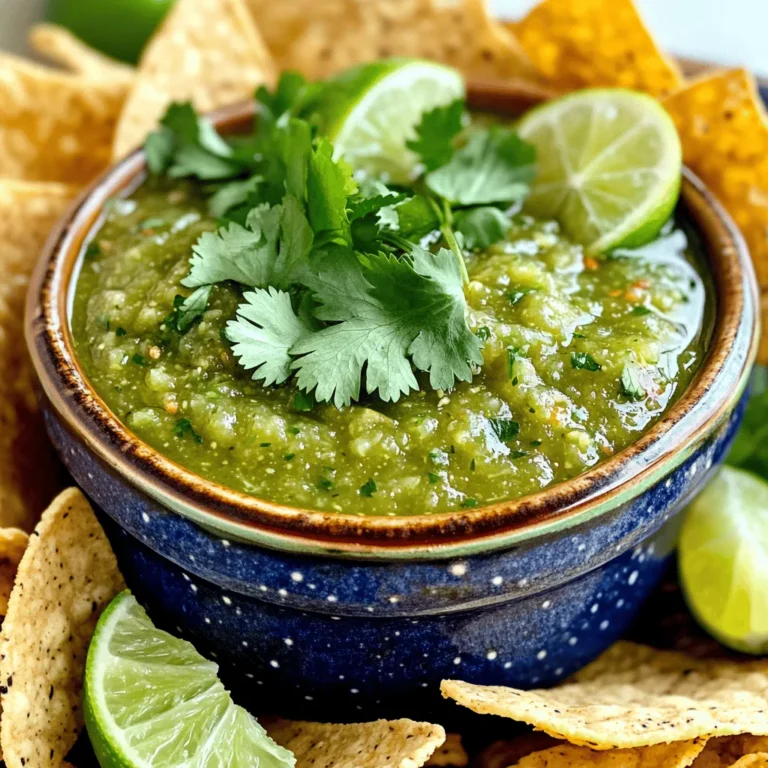If you love fresh flavors, this Homemade Salsa Verde recipe will excite your taste buds! You only need a few simple ingredients to make a zesty dip that can spice up tacos, grilled meats, and more. In this guide, I’ll walk you through easy steps, share tips for perfecting your salsa, and offer fun variations to try. Get ready to impress with the best homemade salsa verde you’ll ever taste!
Ingredients
Essential Ingredients for Homemade Salsa Verde
To make a fresh salsa verde, you need a few key ingredients:
– 10 tomatillos, husked and quartered
– 1 small onion, quartered
– 2 cloves garlic, peeled
– 1-2 jalapeños, seeds removed
– 1/2 cup packed fresh cilantro leaves
– 1 tablespoon freshly squeezed lime juice
– 1 teaspoon salt (or adjust to taste)
– 1/2 teaspoon ground cumin
– 1 tablespoon extra virgin olive oil
These ingredients work together to create a bright and zesty flavor. Tomatillos give a tangy taste, while jalapeños add heat. Fresh cilantro and lime juice balance the flavors well.
Optional Ingredients for Flavor Enhancements
You can also add extra ingredients to enhance your salsa verde:
– A pinch of sugar to balance the acidity
– A dash of smoked paprika for a smoky twist
– Avocado for creaminess
– Chopped green onions or radishes for crunch
Feel free to mix and match these optional ingredients to create your own version. Experimenting can lead to delicious surprises.
Ingredient Substitutions
If you can’t find certain ingredients, don’t worry! Here are some good swaps:
– Instead of tomatillos, use ripe green tomatoes for a similar taste.
– Red onion can replace white onion if that’s what you have.
– If jalapeños are too spicy, use bell peppers for a milder flavor.
– Lime juice can be swapped with lemon juice if needed.
These substitutions keep the essence of salsa verde while making it easier to prepare. Enjoy the process of making it your own!
Step-by-Step Instructions
Preparation Steps for Homemade Salsa Verde
To begin, gather all your ingredients. You will need:
– 10 tomatillos, husked and quartered
– 1 small onion, quartered
– 2 cloves garlic, peeled
– 1-2 jalapeños, seeds removed
– 1/2 cup packed fresh cilantro leaves
– 1 tablespoon freshly squeezed lime juice
– 1 teaspoon salt
– 1/2 teaspoon ground cumin
– 1 tablespoon extra virgin olive oil
Next, preheat your oven to 400°F (200°C). This heat will help roast the veggies and bring out their flavors. Line a baking sheet with parchment paper.
Detailed Cooking Instructions
Spread the quartered tomatillos, onion, jalapeños, and garlic evenly on the baking sheet. Drizzle the olive oil over the veggies. Toss them gently with your hands or a spatula until they are well-coated.
Now, roast the mixture in the oven for around 15-20 minutes. Look for the tomatillos to char a bit and soften. This step is key for a great taste.
Once done, take the baking sheet out and let the veggies cool for a few minutes. This makes them easier to handle.
In a blender or food processor, combine the roasted tomatillos, onion, garlic, and jalapeños. Then, add in the fresh cilantro, lime juice, salt, and ground cumin. Blend until you achieve a smooth consistency, tasting and adjusting the seasoning as needed.
Tips for Blending to Perfection
For a salsa with more texture, pulse the mixture a few times. This adds some chunky bits that create a delightful mouthfeel.
After blending, transfer the salsa verde to a bowl. Let it rest for at least 30 minutes at room temperature. This resting time lets all the flavors mix well and taste even better.
For a vibrant presentation, serve in a nice bowl. Top with extra cilantro leaves and lime wedges. This salsa is perfect for dipping or as a topping for tacos. Enjoy your fresh and zesty homemade salsa verde!
Tips & Tricks
Adjusting Spice Levels in Salsa Verde
To change the spice in your salsa verde, start with the jalapeños. Use one if you want mild salsa. For more heat, add two. Remove the seeds for less spice. If your salsa is too spicy, add more tomatillos or onion. This helps balance the heat.
Best Practices for Roasting Vegetables
Roasting makes your salsa full of flavor. Spread your ingredients evenly on the baking sheet. Don’t crowd them; this helps them roast well. Roast at 400°F (200°C) for 15-20 minutes. Watch for charring, as it adds a nice depth.
Flavor Pairing Suggestions
Salsa verde pairs well with many dishes. Use it on tacos or grilled meats. It’s great with chips or as a topping for eggs. You can also mix it into rice or quinoa for a flavor boost. Try adding it to soups for a zesty kick.

Variations
Different Ingredients to Try in Salsa Verde
You can play with your salsa verde by changing some ingredients. Try adding roasted red peppers for a sweet touch. You can also add avocados for creaminess. If you like heat, try using serrano peppers instead of jalapeños. For a smoky flavor, add a bit of chipotle in adobo. Fresh herbs like mint or parsley can give your salsa a different twist too. Each change brings a new taste to the table.
Combining Salsa Verde with Other Flavors
Salsa verde pairs well with many foods. It adds zest to grilled meats, tacos, and fish. You can drizzle it over roasted vegetables for extra flavor. Mix it into your salad dressings for a fresh kick. I love using it as a topping for baked potatoes or eggs. You can even blend it into dips for a fun twist. The possibilities are endless!
Serving Suggestions for Unique Dishes
Serve your salsa verde in creative ways. Use it as a dip for tortilla chips at parties. Spread it on sandwiches or wraps for added flavor. You can also spoon it over quesadillas or nachos. For a light meal, drizzle it on grilled chicken or fish. Try it with shrimp tacos for a tasty dinner. Each bite will burst with flavor!
Storage Info
Refrigeration Tips for Salsa Verde
To keep your salsa verde fresh, store it in the fridge. Use an airtight container. It can last up to one week. Make sure to cover the salsa well to avoid drying out. If you notice any separation, just stir before serving. This is normal and won’t affect the flavor.
Freezing Salsa Verde for Long-Term Use
If you want to store salsa verde for longer, freezing is a great option. Pour the salsa into freezer-safe bags. Remove as much air as possible before sealing. This prevents freezer burn. You can freeze it for up to three months. When you’re ready to use it, thaw it in the fridge overnight.
Best Containers for Storage
For best results, use glass jars or BPA-free plastic containers. Glass jars provide a tight seal and won’t stain. Plastic containers are lightweight and easy to store. Choose a size that fits your needs. Smaller containers are great for portion control. Always label your containers with the date for easy tracking.
FAQs
What is Salsa Verde?
Salsa verde is a green sauce from Mexico. It mainly uses tomatillos as its base. Tomatillos are small, green fruits with a tart flavor. This sauce is bright, fresh, and zesty. You can enjoy it with chips, tacos, or grilled meats. The mix of roasted vegetables gives it a deep taste. Making salsa verde at home is fun and easy.
How long does Homemade Salsa Verde last?
Homemade salsa verde lasts about one week in the fridge. Store it in an airtight container for best results. Always check for signs of spoilage before eating. If it looks or smells off, it’s best to toss it. You can also freeze salsa verde for up to three months. Just make sure to use a freezer-safe container.
Can I make Salsa Verde without tomatillos?
Yes, you can make salsa verde without tomatillos. You can use ripe green tomatoes instead. The taste will differ slightly, but it can still be tasty. You can also try using other green vegetables like green peppers. Just keep in mind that the flavor will change based on your choice of ingredients.
What dishes pair well with Salsa Verde?
Salsa verde pairs well with many dishes. You can serve it with tacos, grilled chicken, or fish. It’s also great on nachos or with quesadillas. You can use it as a dip for veggies or chips too. The bright taste adds a nice touch to any meal.
Is Salsa Verde spicy?
Salsa verde can be spicy, but you control the heat. The amount of jalapeños you add makes a big difference. If you want it mild, remove the seeds from the jalapeños. For more heat, keep some seeds in or add more peppers. Adjust the spice level to fit your taste!
Homemade salsa verde is easy to make and tasty. With fresh tomatillos and spices, you create a flavorful dip. We discussed essential and optional ingredients to boost your salsa. I shared tips for perfect blending and adjusting spice levels. You can even freeze or refrigerate it for later use. Remember, trying new ingredients can lead to delicious surprises. Explore different flavors and pairings to find your favorite salsa verde. Now, it’s time to enjoy your creation and impress your friends!


